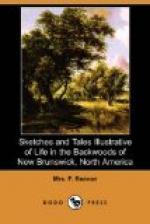totally destroyed—this is a calamity that
to be known must be experienced—the potatoes
stored here are the chief produce of the farm, at least
the part that is most available for selling, for hay
should never go off the land, and grain is as yet
so little raised that ’tis but the old farmers
can do what is called “bread themselves:”
thus the innovation of the cellars by the frost
fiend is a sad and serious occurrence—of
course a deep bank of earth is thrown up round the
house, beneath which, and generally its whole length
and breadth, is the cellar; but the snow over this
is an additional and even necessary defence, and its
want is much felt in many other ways—in
quantity, however, it generally makes up for its temporary
absence by being five and six feet deep in April.
About this season the warm sun begins to beam out,
and causes the sap to flow in the slumbering trees—this
is the season for sugar-making, which, although an
excellent thing if it can be managed, is not much attended
to, especially in new settlements, and those are generally
the best off for a “sugar-bush;”
but it occurs at that season when the last of the
winter work must be done—the snow begins
to melt on the roads, and the “saw whet,”
a small bird of the owl species, makes its appearance,
and tells us, as the natives say, that “the
heart of the winter is broken.” All
that can be done now must be done to lessen the toils
of that season now approaching, from which the settler
must not shrink if he hope to prosper. Sugar-making,
then, unless the farmer is strong handed, is not profitable.
A visit to a sugar-camp is an interesting sight to
a stranger—it may, perhaps, be two or three
miles through the woods to where a sufficient number
of maple trees may be found close enough together
to render it eligible for sugar-making. All the
different kinds of maple yield a sweet sap, but the
“rock maple” is the species particularly
used for sugar, and perhaps a thousand of these trees
near together constitute what is called a sugar-bush.
Here, then, a rude hut, but withal picturesque in
its appearance, is erected—it is formed
of logs, and covered with broad sheets of birch bark.
For the universal use of this bark I think the Indians
must have given the example. Many beautiful articles
are made by them of it, and to the back settlers it
is invaluable. As an inside roofing, it effectually
resists the rain—baskets for gathering the
innumerable tribe of summer berries, and boxes for
packing butter are made of it—calabashes
for drinking are formed of it in an instant by the
bright forest stream. Many a New Brunswick belle
has worn it for a head-dress as the dames of more
polished lands do frames of French willow; and it
is said the title deeds of many a broad acre in America
have been written on no other parchment than its smooth
and vellum-like folds. The sugar-maker’s
bark-covered hut contains his bedding and provisions,
consisting of little save the huge round loaf of bread,




